By Jim Stevenson
I have a very modest report on raptors from this summer. Remember, two years off (2015) I’m putting together a package of trips to Alaska, some extremely reasonable. Next summer (2014) is the Western Trip. Let me know if you’re interested!
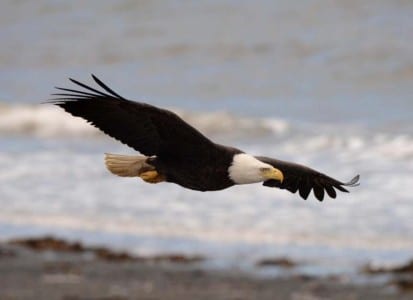
Our Bald Eagle is one of several eagles worldwide with a white head (as adults) and is the only one normally in the New World. They are most common in Alaska, followed by the coastal Pacific Northwest and then the smaller race in Florida. But thankfully, they have re covered over most of their range and are now off the endangered species list. This bird is patrolling the shoreline at Anchor Point, Alaska, on the Kenai Peninsula.
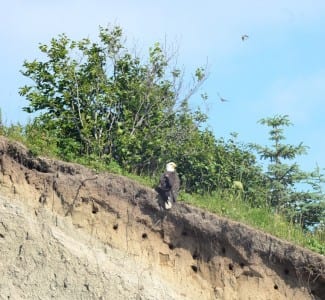
High above the shoreline is a sheer cliff where eagles rest and Rough-winged Swallows nest. The eagles, who have no interest in the swallows or their nests, may actually serve to scare off predators which might otherwise forage in the cavities. There are snakes in Alaska, contrary to certain unnamed sources, but they reside well to the southeast, near the coastal Canadian border. But there are predacious mammals.
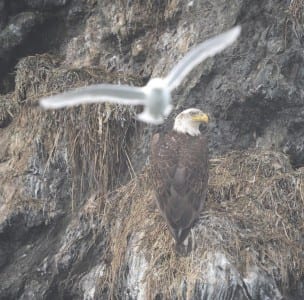
This fourth-year eagle is resting on an old nest high atop Bird Island, off the tip of Homer Spit. The blurred kittiwake is harassing the huge bird in an effort to run it off. Gulls can be a formidable foe and have slightly hooked beaks that serve mostly to rip fish apart. However, eagles aren’t the gulls’ best friends, as the next page shows.
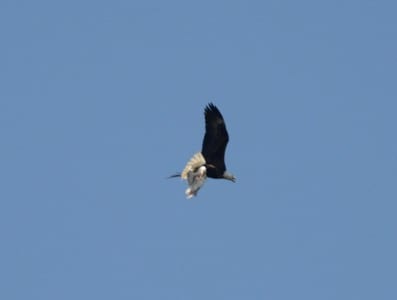
Our National Bird has grabbed a kittiwake and is carrying it off for lunch. Eagles are a lot faster and quicker than we give them credit for, and apparently that goes for kittiwakes (a small gull) as well. Bald Eagles will occasionally take birds, though not commonly, but in the Seattle area they have learned to take domestic cats. That’s a pretty well-armed, strong adversary, but the brute power of an eagle is considerable.
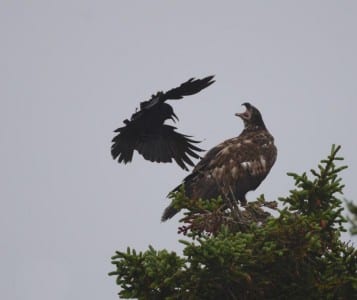
This bird is somewhat wiser than a gull is the Northwestern Crow, much like the American Crow but coastal from southern Washington to southern Alaska. This bird is harassing a first-year eagle and probably trying to run it off from its eggs or (probably) young. It will likely succeed, as most eagles just don’t want to be hassled.
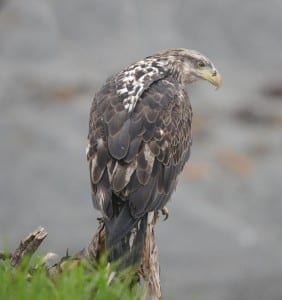
This is probably a second-year bird, and judging from the modest bill, I’m guessing a male. Immature eagles have brown eyes but they turn yellow toward adult plumage. While it takes five years for the full black and white adult plumage, some eagles may be sexually mature before the fifth year. I am reminded of Harold and Maude.
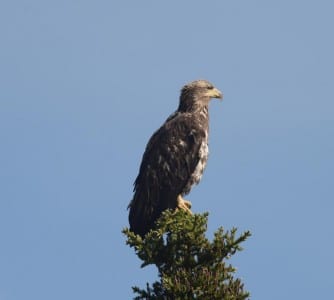
Young eagles in Alaska are quite light on the belly, something not found in the Lower 48 (anyone know of any exceptions?). This is probably a male and certainly isn’t very spruced up (so to speak). The blue skywas nice, and weather tends to run in spells in southern Alaska. But the State had far more sunshine this year than almost any other one on record. And boy is it warmer in summer these days!
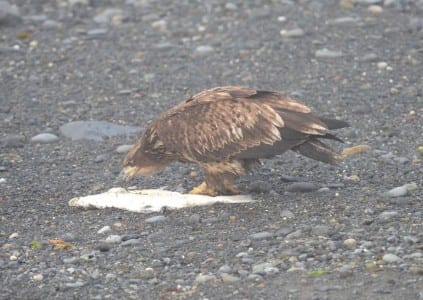
This halibut was cleaned and tossed out on the beach for the eagles. This 2nd-year bird seems to think it’s flat good, and hasn’t yet been mobbed by hungry seagulls. Their beaks are also much darker as immatures than adults but they attain their maximum weight in just a few shortweeks. Flying creatures like birds would have tough times if their growth rate was as gradual as mammals.
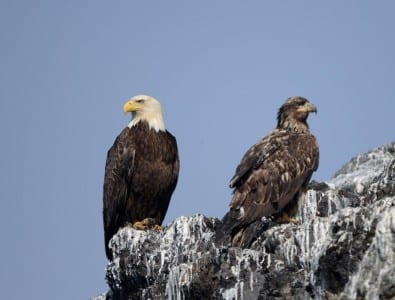
This is undoubtedly a parent and chick, high atop Bird Island. It is not uncommon for two birds of prey to sit looking in opposite directions, covering more ground. I have noticed this especially among the puff birds of the New World Tropics. No doubt you might have thought the immature was Republican, looking to the right, and the left bird a Democrat. Something about that white stuff just made me think about politics.
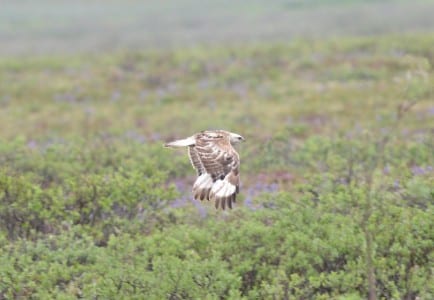
This is NOT a Bald Eagle, though it’s not much of a picture. It’s actually a light morph Rough-legged Hawk, cruising the wet Arctic Tundra for warm-blooded prey. They are basically a tundra buteo in summer, while the dark Red-tail (Harlan’s) takes over in the spruce forest. So often, birds are separated ecologically. These are virtually circum-polar nesters, breeding across much of Eurasia, up on the Arctic Tundra. There are more species found all the way around the Earth in high latitudes because it’s not as far around, and there are also fewer habitats and oceans. Two that come to mind are Golden Eagles, Peregrines and maybe Common Ravens??? Common Eiders? Others become divided into two species, and become “ring species,” where one ends and the other begins, as you go around the Arctic Circle. I believe Herring Gull and Lesser Black-backed may be examples of this. Anybody seen my FIELD GUIDE!!! :0 In the running for one of Jim’s top 5 worstpictures is this Snowy Owl over the west end of Barrow, AK. He is looking dead at me (Tom, remember?) and floated off. Snowy Owls are quite wary on their breedinggrounds, perhaps because they have losttheir color advantage when the snow melts. I hate shooting on dark, overcast days.
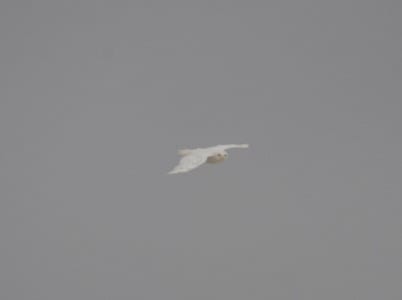
Obviously, with the exception of Bald Eagles, raptors in Alaska aren’t very tame. Sorry.

 Posted in
Posted in 

























I’ve witnessed these regal raptors on the Chippewa in Wisconsin and was blessed to see them here in my home state of Texas- and every time i spot one i’m always in awe of their regal beauty, especially when in flight– and their call is apart from the rest– you’ll know when you hear one calling to its mate– — a truly amazing bird the Bald Eagle is–